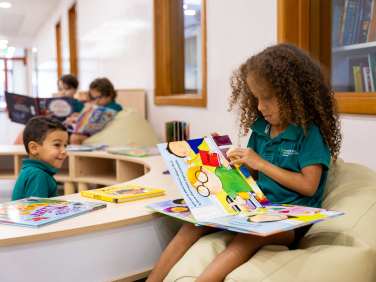Bringing the worlds of educators and architects togeher
Jenny Mollon, Director of Education at KidzInk and her colleague, architect Neha Anna Sibu, discuss how fostering open dialogue leads to successful school design.
Mutual understanding
JM: The creation of inspiring, effective and sustainable learning spaces requires a thoughtful and open dialogue between architects, designers and school stakeholders. On the face of it, this should be straightforward enough. However, adjusting to each other’s specialist environment, understanding each other’s often-technical vocabulary and myriad of ‘unknown un-knowns’ can pose challenges for both designers and educators as they tune in to each other’s world.
Neha, what is the best way for school leaders to open a dialogue about school architecture or design?
NAS: Architecture is a broad and vast discipline, but in simple terms it is a thoughtful way of designing buildings and spaces to fulfil specific purposes while taking into account both functionality and aesthetics. Schools are unique environments to design, very different to, say, an office or home. I therefore think that the very first conversation between educators and school designers should focus wholly on educational philosophy, pedagogy and goals.
The initial responsibility for fostering an effective dialogue is, in our view, the architect’s. At KidzInk, all our architects and designers are trained to ask questions which will uncover a school’s vision, values, and pedagogical approach. Ultimately, what we want to do is create a design approach that supports a school’s educational mission. Deep discussions about education before we even start to think about architecture or design are vital.
JM: Once an architect or designer understands a school’s educational philosophy, what comes next?
NAS: We work hard to continually improve our connection with every school we work with. Our design process includes frequent, interactive planning sessions where children, teachers, school leaders and community members can contribute ideas, insights and expertise.
It’s important, when designing for vocational learning, to consider what different industry workplaces look like in the world outside of education. For example, if a job requires you to work in a lab space, then it is important that students learn to do the job in a lab space as well, so it is key that designers consult industry professionals to properly plan out what these vocational learning spaces will need in order for students to successfully immerse themselves.
Elfyn Wyn Jones, Director of Design and Innovation at Kidzink
In one of our planning sessions, we encourage school stakeholders to dive deep into specific needs, preferences, and (of course!) challenges. Our job as architects and designers is to engage and listen, and then to come up with innovative solutions. These planning sessions should be revisited frequently to ensure that the design process is an evolving and collaborative journey, rather than a one-time transaction.
JM: What top tips can you give to a school leader who is about to embark on a school design project?
In my job at KidzInk I get to focus solely on the world of education. It’s taken me back to my school days and reminded me that schools are highly dynamic, ever-changing environments! We advise school leaders to think not only about the school that they need today, but also to try to envisage the children and community that it will serve in the next 10-20 years.
In terms of the educator – designer dialogue, having regular discussions about potential changes in curriculum, teaching methodologies or technology integration to help architects and designers create truly flexible spaces that will adapt to the school’s future requirements is essential.
JM: You mentioned technological integration. How can school leaders predict the technology their school will need in years to come?
Designing for technology: new DT Labs at NAIS, Dubai
NAS: As architects, we want to hear about the technological aspirations school leaders have for their school, even if those ideas aren’t intended for immediate implementation. It’s much easier to integrate technology in a planned fashion, than it is to adapt spaces retrospectively. An architect who really understands schools can provide insights on incorporating tech solutions without compromising the aesthetics or functionality of a learning space.
JM: How should a school leader explain their sustainability goals to an architect or designer?
NAS: The all-important question! Every-last one of my colleagues wants to design the most sustainable school possible. To do so, we must take the time to understand each school’s context, location, community, and financial resources.
Of course, designers and schools can work together to explore eco-friendly options, energy-efficient systems, and sustainable materials, but it is possible to go much further than this.
Kidzink Lead Project Engineer, Jeff Ivan, talks about working with RGS Guilford Dubai UAE.
The world of education and architecture is interconnected and reciprocal, with each influencing and responding to changes in the other. I hope to create spaces which inspire students to think about the world around them, and which act as catalysts for ongoing ideas about sustainable living. Great architecture and design should make sustainable living a seamless part of everyday life: this is true everywhere, in homes, workplaces, leisure venues and schools.
JM: Neha, you have worked with many schools. How do you ensure each design is unique?
Our team includes experienced educators and marketing/brand professionals, and they are key to facilitating communication and creating our design concepts. Simply put, they enhance and translate the professional jargon . . . in both directions! Most of the schools we work with are fee-paying, private entities and our branding team are there to ensure that our designs amplify and enhance each school brand.

Ultimately, architects and designers want to create learning spaces where children have a sense of contentment and belonging. Well-designed classrooms, libraries, and common areas create positive and conducive learning environments. Natural light, open spaces, and ergonomic furniture enhance the overall educational experience. Once all that is in place, we know that is the educators and (most importantly!) the children, who make each school wonderful place to be.
If we have listened properly, it will also be unique.

 Jenny Mollon is Director of Education at specialist school design company, Kidzink, where Neha Anna Sibu is an educational architect.
Jenny Mollon is Director of Education at specialist school design company, Kidzink, where Neha Anna Sibu is an educational architect.
For more information about their work see: www.kidzinkdesign.com
Recognition for KidzInk:
 The annual Fast Company Middle East Innovation Awards saw Kidzink presented with the award for The Most Innovative Company in Education in the Middle East. November 2023
The annual Fast Company Middle East Innovation Awards saw Kidzink presented with the award for The Most Innovative Company in Education in the Middle East. November 2023
Feature and support images kindly provided by Kidzink

